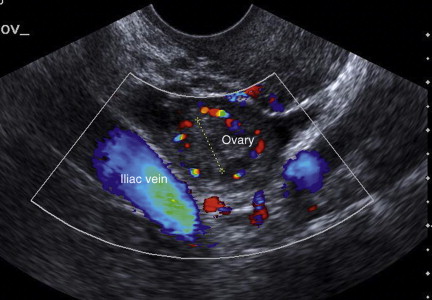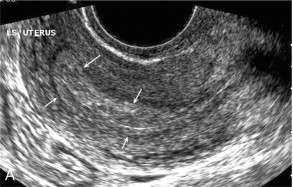Physical Address
304 North Cardinal St.
Dorchester Center, MA 02124
Ultrasound is integral to modern gynaecological practice. This has been recognised by bodies such as the Royal College of Obstetricians and Gynaecologists, who have made ultrasound part of the core requirements in their training modules. Assisted conception units have long been aware of the value of ultrasound. Monitoring of ovaries during stimulated cycles, egg retrieval and assessing the early development of the implanted gestation are but a few of the techniques that could not be done without ultrasound assessment. Transvaginal ultrasound has allowed much more detailed inspection of gynaecological physiological and pathological processes by being able to place a high-frequency transducer next to the organ(s) of interest. However, using the greyscale appearances of the changing ovaries and endometrium through the menstrual cycle only takes one so far. Doppler techniques allow the blood flow in these organs to be assessed. For instance, it has been shown that reduced perfusion of the sub-endometrial myometrium is associated with sub-fertility. Furthermore, most pathological processes involve alteration of the normal vascular pattern. These changes need to be distinguished from the physiological neo-vascularisation that occurs in the ovary around the developing follicle with each menstrual cycle. Hitherto, our ability to distinguish the disordered vascularity of a malignant process from the increased flow seen in benign tumours, physiological changes and inflammatory conditions has been poor. Recent research has concentrated on overall flow quantification using three-dimensional (3D) power Doppler but there are many conditions in which the use of more conventional Doppler techniques is better known and more widely researched. Contrast-enhanced ultrasound (CEUS) is also beginning to find niche roles within gynaecological practice; for instance, the use of ultrasound contrast agents in assessing tubal patency is well known. This chapter will set out the current state of knowledge on the application of Doppler techniques in these various gynaecological conditions.
Correct identification of the pelvic vessels is essential for accurate Doppler assessment and interpretation. Gynaecological applications place emphasis on the uterine and ovarian vessels but the relationship of the other major arteries and veins in the pelvis is also important. Gynaecological masses may compromise the iliac veins or, alternatively, iliac artery pathology, such as an aneurysm may mimic an adnexal mass unless correctly identified.
The iliac artery arises at the aortic bifurcation and courses inferiorly and laterally to emerge at the groin as the common femoral artery. The approximate surface markings for this course are given by a line from the umbilicus to the point of maximum pulsation in each groin. The common and external iliac veins run posterior and medial to their accompanying artery. The paired artery and vein often form a lateral boundary to the ovaries ( Fig. 14-1 ). The internal iliac artery arises medially from the common iliac artery approximately 4 cm from the aortic bifurcation. The internal iliac artery divides into anterior and posterior branches; the uterine artery arises from the anterior branch. The uterine artery runs in the base of the broad ligament medially to the cervix, where it gives branches to the upper vagina and cervix. It ascends in the broad ligament giving off branches to the myometrium until it reaches the cornual region. Here it turns laterally to supply the fallopian tube and ovaries and anastomoses with branches from the ovarian artery. The uterine vein mirrors the artery’s course and eventually drains into the internal iliac vein.

The ovarian artery arises from the aorta just below the renal arteries. It runs in the retroperitoneum behind the paracolic gutter, crossing the ureter and psoas muscle. At the pelvic brim it enters the suspensory ligament of the ovary and runs to the lateral end of the broad ligament below the fallopian tube. Branches supply the ovary and fallopian tube as well as anastomosing with uterine artery branches. Consequently, the ovary has a dual blood supply. Ovarian veins arise from a venous plexus in the mesovarium and suspensory ligament, they accompany the ovarian artery, draining into the renal vein on the left and the IVC on the right.
An empty bladder may improve the geometry for assessing uterine artery flow by transabdominal scan. Transvaginal scanning has made many pelvic vessels much more readily accessible for study, particularly improving visualisation of the ovarian artery.
The area of interest is first identified on greyscale ultrasound. Initial interrogation with colour Doppler often uses quite a large colour box. The size of the box should be altered to suit the size of the area of interest. A smaller colour box allows better frame rates and pulse repetition rates, which in turn improve detection of flow. It may be necessary to move a small colour box around over the area of interest and it may be necessary to alter machine settings to look for high and low flow velocities. Flexibility of approach and familiarity with the machine controls will improve the accuracy of the Doppler information.
The following generalisations apply:
A low filtration setting is needed, particularly when assessing pelvic venous disease and perfusion of tissues.
A moderate degree of colour persistence is usually best.
Velocity ranges should be chosen to suit the vessel being investigated. Blood flow in most pelvic veins is up to 10 cm/s, whereas most arteries have peak systolic velocities of 10–50 cm/s.
The angle of insonation should be as small as possible, ideally less than 60°, but the shape of the pelvis may limit the positioning of the probe with either transabdominal or transvaginal approaches. Resistance and pulsatility indices are angle independent but measurement of peak velocity requires accurate angle correction.
The genital vessels are generally small, so a small spectral sample volume should be used to better fit the vessels.
Machines capable of 3D volume scanning are usually also capable of 3D colour power Doppler scanning. The colour box size is chosen to encompass the structure of interest. The resulting data volume can then be interrogated, either on or off line, to yield a number of perfusion indices. Potential indices are: vascularisation index (VI), which is the percentage number of colour voxels in the region of interest; or the vascularisation flow index (VFI) – the mean colour value of all the voxels in the region of interest.
The vessels being interrogated are often small so the spectral Doppler sample volume may encompass other structures that confuse the spectral trace. If both arterial and venous components are included it may confuse the operator about the true diastolic flow.
Colour and power Doppler may produce signals even in the absence of flow. This may be because too much gain is applied but it may be because of bowel wall motion, or reverberation artefact behind calcification or tiny cysts. Some have used this artefact to better detect small calcifications (most usually in looking for renal calculi).
Dysfunctional uterine bleeding is one of the most common gynaecological complaints. Many cases will have an underlying hormonal cause but in up to half of these cases ultrasound may reveal an underlying structural defect – the most frequent being submucosal fibroids, adenomyosis or endometrial polyps. The Doppler characteristics of each of these will be discussed later. However, Doppler also has a more general role to play in these cases as it has been shown that women with pain on menstruation have increased myometrial vascularisation during the early menstrual phase, and that those with irregular bleeding are also more likely to show increased perfusion of uterine and sub-endometrial blood vessels ( Fig. 14-2 ). The pathophysiology underlying these observations is not yet fully understood. Endometrial ablation is a recognised treatment of dysfunctional bleeding but measurement of the Doppler indices in the uterine arteries does not help determine who will show a good response to ablation; although assessment one year after ablation helps predict the duration of amenorrhoea or eumenorrhoea.

Become a Clinical Tree membership for Full access and enjoy Unlimited articles
If you are a member. Log in here